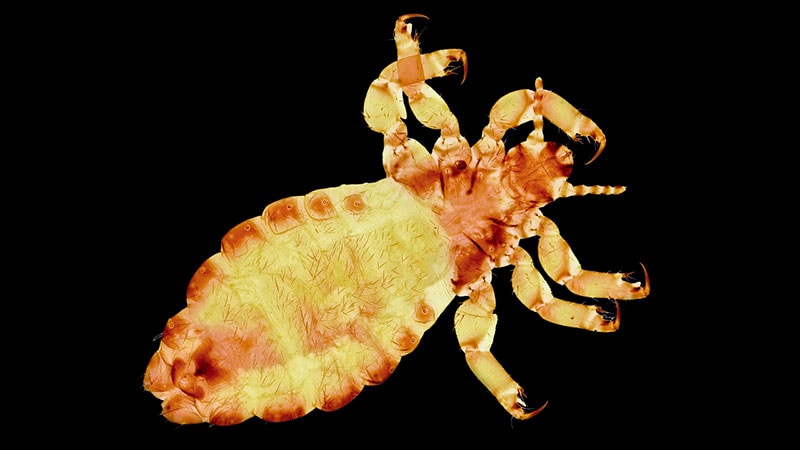Editor’s note: Find the latest COVID-19 news and guides at Medscape’s Coronavirus Resource Center.
PARKER, Colorado – The Marker family recently opened their door to a woman dressed in purple with a military attitude towards cleanliness.
Linda Holmes, who has been a technician at LiceDoctors for five years, came straight from her job in a hospital after receiving a call from a dispatcher that the Marker family needed her as soon as possible.
Pediculus humanus capitis, the much despised head louse, has returned.
“It’s definitely back,” said Kelli Boswell, owner of Lice & Easy, a boutique where people in the Denver area can be deloused, a process that can take anywhere from minutes to hours, depending on the method and infestation. “It’s a sign that things are going back to normal.”
Colds and more serious bugs like respiratory syncytial virus, better known by the acronym RSV, are also back. This may surprise some: How do children share these things with all the Covid prevention measures?
Like the coronavirus, all of these errors depend on human sociability. Unfortunately, the measures many reopened schools have taken to prevent the transmission of Covid-19 – masks, hand washing, vaccinations – do little to prevent the head lice from spreading. However, physical distancing, such as
In theory, lice are more difficult to spread than the SARS-CoV-2 virus because proximity alone is not enough: they usually need head-to-head contact. If a child gets lice, it likely means that the child has spent time around another child for the parasite to move around. (Researchers agree that transmission through inanimate objects such as combs and hats is minimal.)
The head louse is not known for its strength or athletic ability. It is basically the couch potato of the pests. Adults cannot survive for more than a day or two without eating blood. Your eggs cannot hatch without the warmth of a human head and will die in about a week, if not in these cozy conditions. The beetles cannot jump or fly – only crawl. The only thing that speaks in favor of the head louse is its highly specialized claws, which are designed to grip human hair.
Unlike the body louse, the head louse is not known to spread disease. An infestation says nothing about a person’s hygiene. (In fact, delousing lore has it that the beetles prefer clean hair because it is easier to grasp.) And despite widespread misconception, they can colonize people of all ages, races, and ethnicities.
Covid locks weren’t great from a louse world domination standpoint. But the critters have been associated with us for tens of thousands of years. A little lockdown wouldn’t end the romance.
Federico Galassi, a researcher at the Argentine Pest and Insecticide Research Center, found that strict early Covid lockdowns actually resulted in a decrease in head lice in children in Buenos Aires, but the bugs were far from eliminated. His study found that the prevalence fell from around 70% to around 44%.
And one thing is clear: when people closed their doors and ducked in early lockdowns, the lice were exactly where they crouched down with us. When SaLeah Snelling reopened the doors of her Lice Clinics of America salon in Boise, Idaho, in May, she said, “The cases of head lice have been more severe than we’ve ever seen.” And there wasn’t just one or two people in the household with lice, but the entire household.
Now, according to Galassi and American rascals, infestation rates have returned to pre-lockdown levels despite the protection of school covids.
Nix, a brand of anti-louse products, publishes a card claiming lice are currently bad in Houston, most parts of Alabama and New Mexico, as well as Tulsa, Oklahoma. The map leads people to places to wear their products as many parents take a DIY approach once they spy on the animal on a child’s head.
Richard Pollack, chief scientific officer of pro bono pest identification service IdentifyUS, said most of the allegations about louse prevalence were “marketing nonsense” of a largely unregulated industry that focuses on obvious infestations, often just shed, glitter , Hairspray, grass-dwelling springtail insects, harmless mushrooms, or even cookie crumbs.
It is possible that the recent surge in the professional nitpicking business suggests that people are now feeling more comfortable seeking help outside of the home, rather than being a sign of an increase in bugs.
While there’s little research to confirm whether there’s an increase in lice, Boswell, Pollack, and even the National Association of School Nurses agree: the beetles likely won’t spread in the classroom because lice transmission is in the school is considered rare. Instead, Boswell said, the beetles are more likely to thrive again upon resumption of other activities – overnight stays, play dates, summer camps, family gatherings.
Pollack once wrote on a presentation slide: “Head lice indicate that the child has friends.” Preschoolers tend to get the infestation most often “because they’re snuggly,” said Julia Wilson, co-owner of Rocky Mountain Lice Removal in Lafayette, Colorado. But she has also noticed an increase in teenagers, which she attributes to selfies with pals.
“You say to them, ‘Have you touched heads?’ and the teenager says, ‘No, never,’ “said Wilson. “And then all of a sudden they are literally taking a selfie photo with their friends.”
The Marker family isn’t sure where the third grader Huntley’s lice came from. Maybe a close friend or your dance team? The Markers spent more than $ 200 getting the four-person household checked – eyebrows and daddy’s beard included. Her dad and preschool-aged brother were nit-free. But Holmes found a few nits on Huntley’s mother, Paris.
“You can just burn my whole head right now,” said Paris.
After carefully combing each head, Holmes ended the session with a good-bye hug from her clients, proof that she trusted her job.

